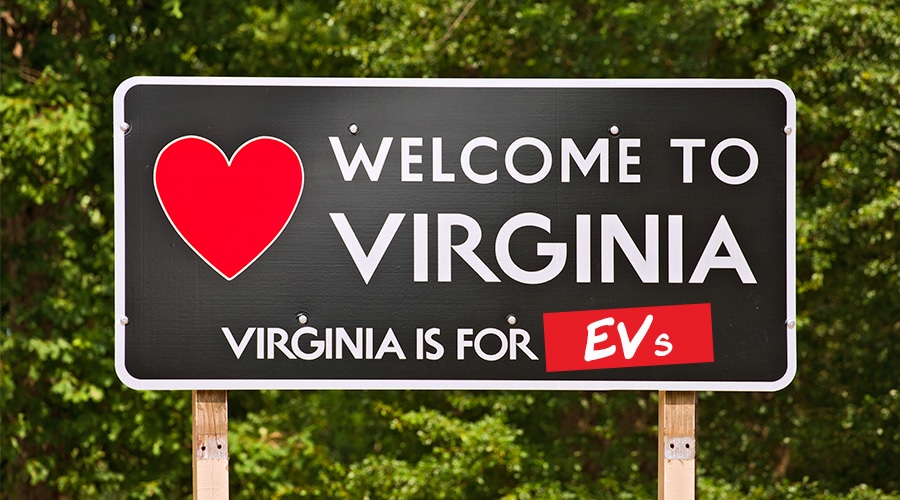Bust out some bubbly, y’all: the 2021 General Assembly, which officially wrapped up yesterday (Monday 3/1), took huge strides to electrify Virginia’s transportation sector, the leading source of carbon emissions in the state.
This progress came on the heels of last year’s historic session, in which Virginia adopted landmark legislation to transition the state to a clean energy economy. It’s worth taking a moment to understand what these new EV policies mean for Virginians, outline what we need to do next, and—most importantly—celebrate a bit. We’ve made fantastic progress, and it’s time to keep the momentum going.
With support from a broad coalition of environmental nonprofits, industry voices, and constituents, five bills that promote electric vehicles successfully passed both the House of Delegates and the Senate. Earlier in the session, Del. David Reid, chief patron of the EV rebate, summarized the key areas that the package of legislation helps address: “These bills are part of a comprehensive program to address the supply, demand, infrastructure, and funding components of a broader electric mobility transition, with a particular focus on helping low-income Virginians.” The simple goal that these bills work toward: make it as easy as possible—as quickly as possible—for all Virginians to switch from a gas-powered ride to an electric one.
Here’s an overview of what this means for you and how we keep the up the momentum moving forward:
What this means for Virginians
At this point in the game, everyone agrees that electrifying transportation is a crucial step in any state (or country’s) shift to a 21st-century clean energy economy. It’s a step that will bring a myriad of recognized economic, public health, and climate benefits.
Economically, these bills will better position Virginia today to capture the economic benefits of tomorrow. With over half (53%) of Virginians saying they’re likely to consider an EV for their next car and nearly 100 new electric models (including SUVs and pickup trucks) set to hit the market by the end of 2024, waiting to get on the EV bandwagon would’ve meant missing out on major economic opportunity.
Economically, these bills will better position Virginia today to capture the economic benefits of tomorrow.
Another result: Virginians are on their way to cleaner air and better public health. Making EVs more available on dealership lots and more affordable to Virginians across the economic spectrum will do real work tackling an air pollution problem that accounts for 92 deaths, 2,600 cases of exacerbated asthma, and 10,000 lost workdays in Virginia every year. Cruelly, this suffering hits communities of color and vulnerable populations the hardest, research shows. The EV Charging Infrastructure bill, additionally, requires the State Corporation Commission to focus charging policy proposals on low-income, minority, and rural communities.
Lastly, these bills together are a strong response to a critical window of opportunity in the climate crisis. Given that most of these bills will take years to kick in, get funded, or have an impact, it was vital that Virginia start tackling its largest source of carbon emissions: transportation. There’s simply no time to waste.
Here’s a quick summary of what each bill will do:
- Availability of EVs: the Advanced Clean Car Standards will require manufacturers to send more EVs to Virginia’s auto dealers
- Affordability of EVs: the EV Rebate Program will reduce the upfront price of new and used EVs by $2,500 (and more for low- and moderate-income buyers)
- EV buses for Schools: the EV Grant Fund and Program creates a new fund can receive federal or philanthropic dollars and use them to help schools replace diesel school buses with electric ones
- EV chargers: the EV Charging Infrastructure bill directs Virginia’s public utility commission (the State Corporation Commission) to consider transportation electrification policies and ensure better access to charging stations across the state.
- Include EV charging in the bigger plan: The Virginia Energy Plan & EV Infrastructure bill amends the Virginia Energy Plan to include an analysis of electric vehicle charging infrastructure needed to support the 2045 net-zero carbon target in the transportation sector.
What needs to happen next
There are two main things that need to happen in order to build off this positive momentum: 1) legislators need to put the money where their mouth is, and 2) constituents like us need to make clean energy action a priority in this November’s election.
Two of the bills, the EV Rebate Program and the EV Grant Fund and Program, now need funding. Without funding, of course, these programs won’t functionally exist. While passing them is indeed a win worth celebrating, each has a critical second step. This step must be taken in the 2022 General Assembly session.
Two of the bills, the EV Rebate Program and the EV Grant Fund and Program, now need funding.
Secondly, all House of Delegate seats are up for reelection this year. This is the moment when voters can have their most direct impact on the system. Ask candidates how they’ll continue this momentum that’s been building over the last two years. Put your energy behind candidates that prioritize clean energy. It’s hard to overstate that forward progress is essential; we don’t have time to pause, move sideways, or (please, no) move backwards.
So let’s take a moment to celebrate: Virginia now has a suite of electric vehicle bills that match the urgency of the moment. Let’s keep Virginia moving in the right direction.
Live in Virginia? Use our tool to quickly send your elected officials a “thank you” email.















